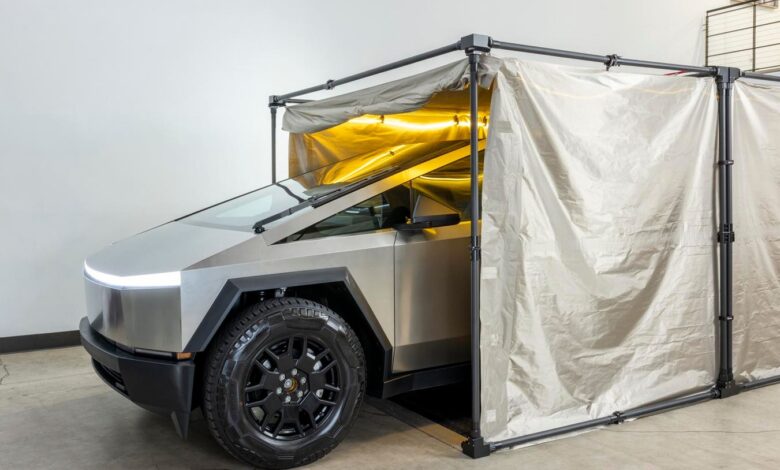This High-Tech Tent Can Prevent EMP Attacks From Crippling Cybertrucks

Santa Barbara-based Mission Darkness developed the Cybercylent tent to protect Cybertrucks from EMP … [+]
As Tesla’s Cybertrucks continue proliferating on public roads, the electric vehicle industry appears one step closer in the evolution toward becoming increasingly complex computers on wheels. But amid recent threats of electromagnetic pulse (EMP) attacks—against Israel by Iran or the United States by Russia—and the recent film I.S.S., the attention of many electric vehicle owners has turned to the potential for a bad actor to use a device that renders all electronic systems within a blast area inert.
In response, a company based in Santa Barbara, California called Mission Darkness recently unveiled a tent called the Cybercylent that is specifically designed to protect Cybertrucks from EMP attacks.
Mission Darkness developed a proprietary nickel-copper coating that attaches to polyester to prevent radiation penetration, and dubbed the result “TitanRF Faraday Fabric.” The tent then uses adhesives to prevent stitching from causing tiny holes in the fabric, and the doors require three rows of neodymium magnets to reduce the chances of unintended ripples or folds in the material. Mission Darkness spent a year developing the door alone, but also uses tiny wave guides for air vents, which are essentially dense waffled grilles that compress radiation wavelengths enough to prevent entry. Carbon-fiber for the frame and brackets make the tents lightweight and easily deployable, ideal for customers who want to install a Cybercylent in their garage.
Proprietary TitanRF Faraday Fabric uses nickel-copper-coated polyester, adhesives, and magnets to … [+]
Mission Darkness founder Ryan Judy readily admits that the Cybertruck naming for the techy tent largely caters to excellent marketing imagery, since any vehicle in the modern era runs the risk of shutting down due to an EMP attack. Even if the marketing imagery therefore focuses largely on the doomer and prepper mentality, in fact, Judy already sold a few tents to Tesla itself, so engineers can use the shielded space to test app connectivity in a perfectly neutral environment. This is possible because the TitanRF Faraday Fabric blocks out 5G, 2.4 and 5-gHz Wi-Fi, Bluetooth, GPS, RFID, and traditional radio signals.
Testing for the TitanRF Faraday Fabric shows that it meets the United States military’s standardized MIL-STD-188-125-1 levels of protection. That’s a theoretical attempt to mimic attempted penetration by electromagnetic energy in the frequency range of 30 MHz to 1 GHz. But to be clear, no known EMP attack by any bad actor has ever occurred, or affected any electric vehicles to date. And these EMP protective tents don’t run cheap: A Cybercylent tent starts at $15,000 and Mission Darkness also sells many different sizes, many of which hint at the company’s main revenue stream catering to government agencies far more than private citizens.
Judy founded Mission Darkness in 2015, and the company specializes in providing law enforcement and the military with technology that blocks radiation of all kinds. Think of smartphones confiscated from criminals or terrorists, full of data that could potentially be wiped remotely. Mission Darkness builds cubbies and boxes that allow law enforcement to maintain the chain of evidence, while also keeping the phones charged as software attempts to crack a smartphone’s password.
Mission Darkness specializes in producing secure lockers, cases, bags, and tents for military and … [+]
Multiple military branches also use Mission Darkness tents, cases, boxes, and fabric to protect communications hardware, create secure meeting spaces in the field, to isolate suspects or prisoners, and even protect high-sensitivity optics on firearms.
The same technology crosses over to corporate and private sales, including phone cases, computer cases, larger bags for devices such as generators, and even yards of the nickel-copper-coated fabric for use between drywall layers during home construction. The latter also applies to government buildings currently being erected—not so for the hats and beanies that Mission Darkness sells, which seem more like a real-world version of proverbial tinfoil hat-wearing conspiracy theorists.
The Cybercylent tent markets toward Cybertruck owners, but can fit just about any car or truck on … [+]
While it’s not entirely unreasonable to worry about EMP events orchestrated by bad actors, the likelihood remains low. Still, a recent government-funded EMP commission’s report estimated that up to 90% of Americans would die within a year of a major high-altitude EMP attack. And solar flares or volcanic eruptions can also cause electromagnetic pulses, too.
Of course, the idea of driving a Cybertruck around in the potential post-apocalyptic wasteland created by any form of EMP going off certainly seems absurd. But the image plays right into the marketing of the Cybercylent tent and, to an extent, the dystopian aesthetic of the Cybertruck itself. And despite the unlikelihood, the pricetag, and lead times of around six weeks for customers who order a Cybercylent, Mission Darkness can’t build the tents fast enough.



